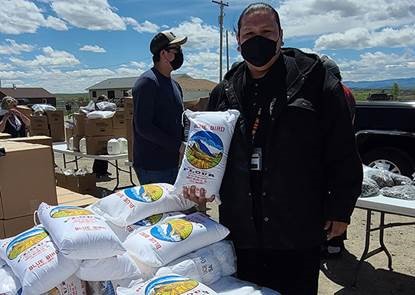Building off the success of a pilot, Food Bank of the Rockies is increasing its commitment to providing culturally relevant food to ethnic groups.
Its Culturally Responsive Food Initiative, started in August 2020 as a pilot in eight counties, is now expanding to include all 53 counties in the food bank’s network. By June 2022, the program is expected to distribute more than one million pounds of culturally appropriate food through both partner agencies and dedicated mobile pantries.
The Initiative’s expansion comes at a time when many food banks are stepping up their efforts to address the tastes and preferences of various immigrant and ethnic groups. Food Bank of the Rockies’ effort stands out for the broad scope of its commitment, combined with its attention to detail.
Like many new initiatives now being undertaken by food banks (such as home delivery), the food bank’s foray into ethnic food was partially spurred by the pandemic.

Pre-pandemic, dozens of listening sessions and visits to pantries had revealed that clients preferred to receive food that was more familiar to them. “Our company line had always been that we don’t get that food donated,” said Erin Pulling, President and CEO, a response that makes sense for food banks following a model of distributing only donated food.
During the pandemic, however, Food Bank of the Rockies, like many food banks, dramatically increased its food purchasing, in its case from 11% to almost 25% of the total. “As long as we were purchasing so much food, we thought we should purchase food that’s familiar to clients and that they’re requesting,” Pulling said.
As it moved toward purchasing more ethnic food, the food bank did not leave much to chance. To determine which foods to purchase during the pilot phase, it collected data from more than 700 clients, 111 partner agencies and 12 cultural community organizations.
The massive data-collection effort helped the food bank identify the seven most prevalent cultures in its service area – Eastern Shoshone, Ethiopian, Hispanic, Northern Arapaho, Russian, Somali and Vietnamese. From there, the food bank created very specific food lists for each culture, aimed at helping partner agencies make informed choices when placing orders on behalf of those communities.
The detailed lists include notes on which foods to avoid, as well as the timing of important holidays and the foods used to celebrate them. Each document also refers to a list of sources. For example, the food list for the Eastern Shoshone tribe is based on online and telephone surveys with 66 community members, as well as a focus group of 10 tribal members, with special care taken to ensure input from Elders.
In its research, the food bank identified 15 foods that are common across all or most of the cultures and increased the average availability of those foods by 80%. Cucumbers and onions, for example, are favored by all cultures, while limes and peppers are favored by six of the seven.
Using the Top 15 list, pantries serving a wide range of cultures can prioritize their orders. Pantries can also tap into $3 million worth of credits the food bank made available for ordering culturally responsive food at no cost.
A fleet of ten culturally specific mobile pantries launched during the pilot phase will be expanded during Phase Two of the program, as the food bank broadens its reach to more counties. In a related initiative, 21 pantries have so far taken part in training on how to run more socially responsible food distributions and another 20 will do so in the spring. Among the advisements: consider using non-uniformed police officers for traffic control during distributions as a courtesy to potentially wary undocumented clients.
Pulling acknowledges that distributing culturally sensitive food is costly. Specialized ethnic food is two to five times more expensive per pound than regular food, plus it’s usually purchased in smaller quantities, she said. The food bank is also hiring three full-time and one part-time staff members to support the initiative.
A $643,000 grant from Feeding America and a $100,000 grant from Albertsons helped fund the pilot phase of the program. Phase Two of the program will cost an estimated $1 million, which the food bank will support through some targeted funding and general fundraising. “It’s expensive,” Pulling said. “But it’s been tremendously well-received.” – Chris Costanzo
CAPTION ABOVE: A culturally responsive food distribution at the Wind River Reservation in Wyoming.
Like what you’re reading?
Support Food Bank NewsConnect with Us:










